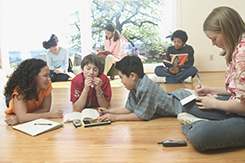Social and Emotional Learning Makes News—and Sense
David Bornstein’s “Teaching Social Skills to Improve Grades and Lives” (The New York Times, 7/24/15) highlights the importance of social and emotional learning (SEL) and the fact that it can be implemented. My research in the same places confirms this journalist’s observations. My findings also do two other things—show how SEL connects with the transparent use of data for continuous improvement and why quality implementation of SEL programs is important. Cleveland, on Bornstein’s map and mine, exemplifies both.
 When my colleagues and I came to Cleveland in 2007 after a school shooting, the mayor, superintendent, and chief academic officer (now the superintendent), and teacher union president told us, “Lay it all out, and tell us what we need to do.” We did. First we interviewed school board members and teacher union leaders, district staff, agency and faith community leaders—more than 100 individuals. Then we surveyed all students in grades 5-12 and visited and interviewed randomly selected students and teachers in randomly selected schools. Finally, we examined attendance, discipline, and safety data.
When my colleagues and I came to Cleveland in 2007 after a school shooting, the mayor, superintendent, and chief academic officer (now the superintendent), and teacher union president told us, “Lay it all out, and tell us what we need to do.” We did. First we interviewed school board members and teacher union leaders, district staff, agency and faith community leaders—more than 100 individuals. Then we surveyed all students in grades 5-12 and visited and interviewed randomly selected students and teachers in randomly selected schools. Finally, we examined attendance, discipline, and safety data.
Our findings? Poor conditions for learning, the need for social and emotional learning, and a lack of systemic student support in a district serving many students who struggle “with the impacts of chronic poverty, lead poisoning and lead effects, community and media violence, drugs and alcohol, trauma and loss.” Our report called for creating supportive environments where students feel connected to teachers and school and develop social and emotional skills, for changing adult behaviors and mindsets, and for employing a data-driven, multi-tiered approach to building conditions for learning and student success.
In 2014, we revisited the 2008 report. Using a similar methodology, we determined what had been implemented since 2008 and how conditions for learning had changed. Even in the Great Recession’s wake, support services and conditions for learning had improved. Services were now systematic and multi-tiered so students could get the amount of help they needed. A good SEL program, PATHS, had been implemented universally through grade 5. In all schools, K-12, planning centers had replaced school suspension rooms. Student support teams were coordinating interventions for students with higher levels of need. And the district was collecting and analyzing the conditions-for-learning data so essential for continuous improvement of interventions and services.
The upshot? These changes contributed to improving student ratings of safety: student support in grades 5-8, peer social and emotional competence in grades 2-4 and 9-12. In other studies, we found that changes in scores for schools’ conditions for learning were associated with improvements in overall school test performance. The rate of out-of-school suspensions also dropped 59% between 2008/9 and 2010/11 in these schools.
These district-wide data look quite promising, particularly given the high level of need in Cleveland, where all students are eligible for free or reduced lunch. That said, changes would probably have been even more impressive had implementation quality been consistently high. In a separate evaluation of the results of implementing PATHS district-wide, we found that as teacher-reported implementation of PATHS increased, so did teacher ratings of students’ social-emotional competence and attention. Similarly, in our 2014 audit, we found an association between medium- or high-quality implementation of PATHS, planning centers, and student support teams, and fewer student suspensions.
Bornstein's description of the multi-district Collaborating District Initiative (CDI) is consistent with our cross-site findings from interviews of central office staff, surveys of school staff, assessment of student social and emotional skills, and the examination of quantitative data on both academic and social and emotional outcomes. In Anchorage, Austin, Chicago, and Nashville, we detected improvements among elementary school students in their social and emotional skills, and achievement across subjects improved in three of four districts where we had consistent data.
More generally, the 300 interviews we conducted over three years captured stakeholders’ perceptions in all districts that SEL was both important in its own right and could and should align with youth development, community schools, school climate improvement, whole child approaches, moves to reduce inequities in achievement and school discipline, and other efforts to engage and support students. As for implementation quality, in two of the three districts where we could link implementation to student outcomes, we found positive associations.
The CDI findings, like those from Cleveland, suggest that the promising outcomes already realized could be enhanced further. The key is building the capacity of teachers and schools to implement SEL and other initiatives so that students can develop the social and emotional skills needed to thrive in school and throughout life. As for getting there, maximizing results calls for leveraging synergies across school initiatives.
David Osher is an AIR vice president & Institute Fellow.
